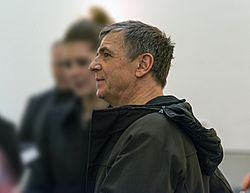Andreas Gursky facts for kids
Quick facts for kids
Andreas Gursky
|
|
|---|---|

Gursky in 2013
|
|
| Born | 15 January 1955 Leipzig, East Germany (now Germany)
|
| Known for | Photography |
|
Notable work
|
Rhein II |
| Movement | Düsseldorf School of Photography |
Andreas Gursky, born on January 15, 1955, is a famous German photographer. He is also a professor at the Kunstakademie Düsseldorf in Germany.
He is well-known for his very large color photographs. These often show buildings and landscapes from a high viewpoint. His artworks are some of the most expensive by living photographers. For example, his photo Rhein II was sold for over $4.3 million in 2011. At that time, it was the most expensive photograph ever sold at an auction.
Gursky shares a studio in Düsseldorf with other artists. This studio used to be an electricity station. It was turned into an art space in 2001 by famous architects.
Contents
Early Life and Learning
Andreas Gursky was born in Leipzig, East Germany, in 1955. His family moved to West Germany when he was very young. They first went to Essen and then to Düsseldorf by the end of 1957.
From 1978 to 1981, he studied visual communication at a university in Essen. He learned from photographers like Otto Steinert and Michael Schmidt. Later, from 1981 to 1987, Gursky studied at the Kunstakademie Düsseldorf. Here, he was greatly influenced by his teachers, Bernd and Hilla Becher. The Bechers were known for their careful way of photographing industrial buildings. Gursky uses a similar detailed approach in his own large photos.
Other photographers also influenced him. These included British landscape photographer John Davies. Davies's detailed photos taken from high up had a big impact on Gursky's early work.
Photography Style and Career
Before the 1990s, Andreas Gursky did not use computers to change his photos. But since then, he has openly used computers to edit and improve his pictures. This helps him create images of spaces that look even bigger than they are in real life.
Critics have described his pictures as "vast" and "unbelievable." One critic, Calvin Tomkins, called Gursky one of the "two masters" of the Düsseldorf School of Photography. Tomkins said that Gursky's huge, wide color prints felt as powerful as old landscape paintings. Yet, they still showed every tiny detail like a photograph. He noted that Gursky's photos show the modern world from a calm distance.
Many of Gursky's photos are taken from a high angle. This allows viewers to see a wide scene, including both the middle and the edges. This broad view often connects to ideas about globalization, which is how the world is becoming more connected.
Gursky often photographs large, everyday places made by people. These include tall buildings at night, office lobbies, and big stores. For example, his photo 99 Cent II Diptychon shows the inside of a discount store. It turns rows of products into colorful patterns.
Another famous photo is Rhein II (1999). It shows a straight part of the Rhine river near Düsseldorf. It looks like a real river, but also like an abstract picture with horizontal bands of color. In his Ocean I-VI series (2009–2010), Gursky used satellite photos. He then added to them using different pictures he found online.
The Museum of Modern Art in New York described Gursky's work as "a sophisticated art of unembellished observation." This means his art is smart and shows things as they are, but in a special way. His style is often seen as mysterious and straightforward. He usually doesn't add much explanation or change to his works.
Art Market and Records
Most of Gursky's photographs are made in limited numbers, usually six copies.
Since 2010, the Gagosian Gallery has represented Gursky's work. He held the record for the highest price paid for a single photograph at auction for many years. His print Rhein II sold for $4,338,500 in 2011. In 2013, another photo, Chicago Board of Trade III, sold for over $3.2 million. This set a record for his photos showing financial exchanges.
Exhibitions
Andreas Gursky first showed his work in Germany in 1985. His first solo gallery show was in Cologne in 1988. His first museum exhibition in the United States was at the Milwaukee Art Museum in 1998. The Museum of Modern Art in New York also held a major show of his work in 2001.
His art has been shown in many important international exhibitions. These include the Venice Biennale and the Biennale of Sydney.
Public Collections
Gursky's work can be found in many public art collections around the world. Some of these include:
- Art Institute of Chicago, Chicago
- Centre Pompidou, Paris
- Kunstmuseum Basel, Basel
- Los Angeles County Museum of Art, Los Angeles
- Metropolitan Museum of Art, New York
- Museum of Modern Art, New York
- Tate Modern, London
See also
 In Spanish: Andreas Gursky para niños
In Spanish: Andreas Gursky para niños
- List of most expensive photographs
- Contemporary art

